360 degrees or classic: 3 action cameras from DJI, Insta360 and GoPro in comparison
Stephan Gölnitz
· 24.10.2025
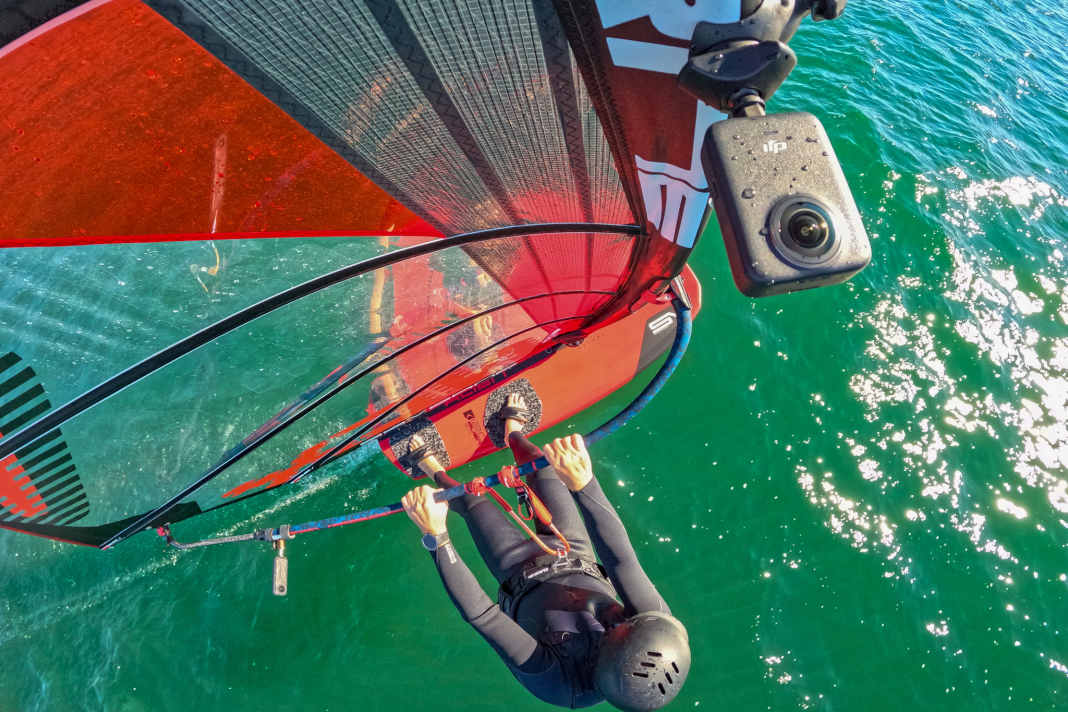



360-degree camera or classic action cam
360-degree cameras with 180-degree lenses on both sides now have the upper hand when it comes to on-board cameras. However, the classic camera with just one wide-angle lens still offers some exclusive advantages. However, 360-degree cameras are much more tolerant when mounted on a rig, for example, because you can play back the viewing direction in the film afterwards. In the mobile app, this is done intuitively by rotating and panning the mobile phone. This results in exciting changes of view of you and other windsurfers - whether for fun with your friends or at a regatta. The classic camera requires more planning and thinking ahead: What do I want to film and from what angle will it look good? How will the mast/boom tilt while I'm surfing? For a straight horizon, for example, you have to think more in advance. 360-degree cameras usually require significantly more time in post-processing and, at full resolution, very large amounts of data are generated very quickly. This abundance of data is probably also the reason for the slower continuous shooting speed in photo mode. If you want to burn your front loop into the memory card as a perfect photo for a poster, you can probably do it on the first attempt with a GoPro at 2 frames per second. The Insta360, on the other hand, takes three seconds to save each image, so there may not be a single photo of a jump.
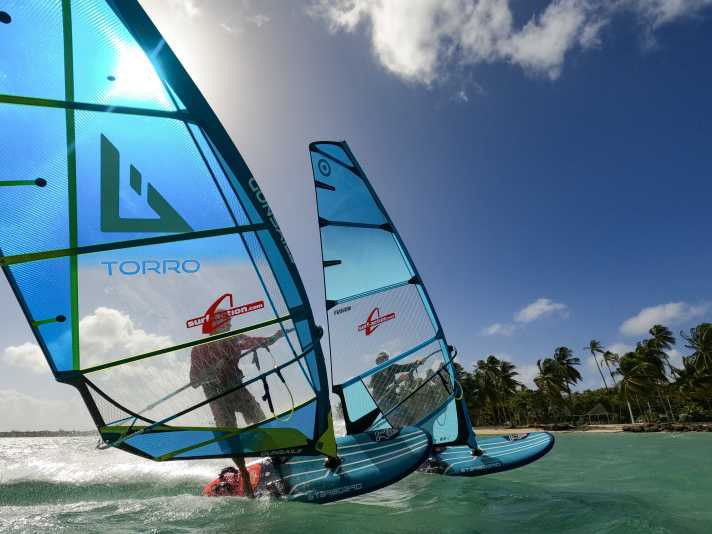
In pure video mode - and especially if you want to be in the picture yourself - the 360-degree technology is unbeatable. You can zoom, rotate and pan almost at will afterwards and simulate dynamic camera movements with just a single montage. If you use a stick when filming: No problem, the DJI software removes it reliably and automatically, just like Insta 360.
However, if you also want to use the camera to film and take photos from your point of view and not just in selfie mode, the classic action camera can sometimes do more than all-round cameras. For example, you can film or take photos from the water from a narrower angle with less distortion and there are more pixels available for photos. However, you have to plan the perspective precisely in advance - or simply go into the water with the camera in front of your eye. Both 360-degree cameras also offer the option of filming with just one lens, which we will try out soon and provide our impressions later.
Decision support for the purchase
If you are looking for a camera for mounting on a rig, board or helmet and mainly film video, the 360-degree perspective is probably the best choice. Of course, the amount of data is larger and post-processing is somewhat more complex, but the possibilities are much more varied. However, editing on a PC is only really fun with a suitable computer. We mounted both 360-degree cameras while windsurfing (in the sunshine) and then reviewed the videos in maximum resolution in the editorial office: Both cameras deliver excellent images, the Insta without post-processing perhaps a little more saturated and already a touch more pleasing, the DJI minimally "flatter" in terms of colour which can all be individually adjusted in post-processing, but also seems super suitable for immediate use in any case. The classic camera (such as the GoPro Hero) comes into play if you actually favour one direction of view: but then the miniature versions (such as the Insta 360 Go 3S, for example) that are currently appearing more and more frequently also come into play, which can be mounted even better on or in a helmet, for example (even when biking). The digital image stabilisation on all three cameras is at such a high level that "camera shake" is no longer an issue. In the following we present the cameras according to our practical impressions, for detailed general video expert opinions we also recommend relevant sources such as chip.de or others.
DJI Osmo 360 in a short test
DJI is the world's leading private drone manufacturer, known for excellent flight characteristics, but also for very good cameras in its flying boxes. Following the classic action camera, a 360-degree camera has also been in the programme since August 2025.
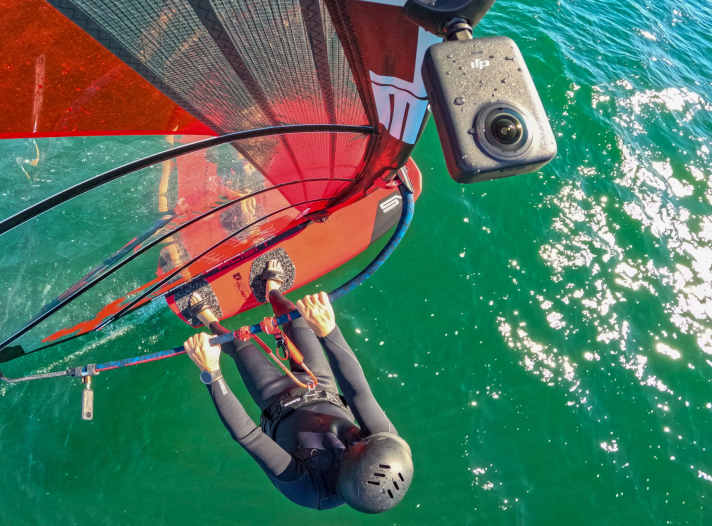
Haptics and handling
The Osmo 360 is based on a different housing design concept to the top dog Insta360, more square, practically good, just like the built-in large 1-inch sensor, which should enable real 8K recordings and particularly good low-light properties. At DJI, the protruding lenses are protected with an additional rubber cap for transport. The lenses can be replaced by DJI at a fixed price in the event of severe damage - if you take out the DJI Care Refresh programme at the time of purchase. The camera must be sent in for replacement. The camera is easy to handle and can be mounted using the built-in thread or the integrated DJI magnetic snap-on quick-release fastener. The touch display is slightly smaller than on the Insta360, but responds very well and smoothly. The three control buttons are almost self-explanatory and arranged in a similar way to Insta360.
DJI Studio
DJI also supplies the appropriate software. DJI Studio is a clearly organised editing platform with the essential features for amateur filmmakers. With the help of so-called key frames, camera pans can be realised very easily during video editing. The software provides a number of filters, tools for colour correction and editing, as well as a selection of music. For recordings other than windsurfing, the automatic rectification, which presumably even straightens the Leaning Tower of Pisa, is interesting. However, a considerable part of the possible image section is lost here.
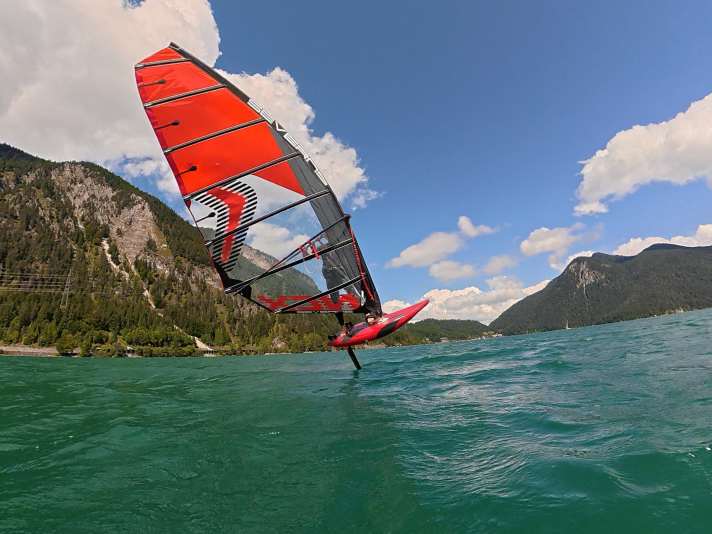
Practical impressions from the short test
In the practical test, we received very nice 360-degree videos from the camera with very good stabilisation. Without any post-processing, the colours sometimes appear somewhat less saturated than from the Insta. However, this can be automatically switched to a very saturated output in the app at the touch of a button. Of course, you can also make your own manual fine adjustments, but a less saturated raw material is usually even better suited for this. Extracted individual images (4K) from an 8K video also looked very good on the screen up to around 50 per cent view size; in the current surf 11-12/2025, an extracted still image is printed at the top of page 44. The photo mode was surprising: in very poor light, the camera impressed with particularly low noise. In medium and good light, however, the DJI did not quite deliver the photo quality of the GoPro Hero 13 black. The viewing angle can be set to comparatively "narrow", which enables less distorted and therefore quite natural-looking shots. The integrated memory of 105 GB is great - forgetting the memory card is no longer a problem.
surf conclusion on the DJI Osmo 360
With the Osmo, DJI is launching a camera that is priced well below the Insta360. The video quality (out of the cam) is very respectable, and editing with DJI Studio is almost intuitive. For videos, the Osmo 360 is a real, inexpensive alternative in the 360-degree segment; in photo mode, we achieved (slightly) better results with the GoPro.
Important technical data of the DJI Osmo 360
- Price: 408 euros (as of 23 October 2025)
- Weight (surf measurement): 192 grams
- Dimensions (manufacturer's specification): 61×36.3×81 mm (W x H x D)
- Sensor size: 1/1.1 inch
- Maximum photo resolution: 6400x4800 (single lens)
- Shortest continuous photo interval: 1 second (not a real continuous photo, but time-lapse video 8K/30)
- Interesting video resolutions: Panoramic video: 8K/50fps and 4K/100fps; single lens: 4K/120fps
- Integrated memory: 105 GB
- Waterproof: 10 metres
Insta360 X5 short test
Haptics and handling
With its elongated shape, the Insta is simply smooth, easy to grip and secure in the hand. Installed on a helmet or rig, the elongated shape sometimes takes some getting used to. The flaps look particularly solid when closed, and the camera is also advertised as waterproof to a depth of 15 metres, 5 metres more than the DJI Osmo. There is a solid internal thread or the integrated magnetic-mechanical quick-release fastener for attachment.
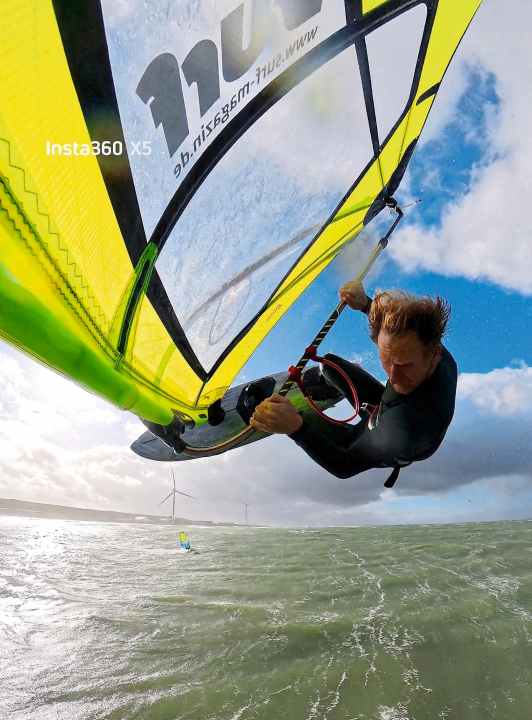
Insta360 Studio
The Insta software offers the essential features of video software with a manageable selection of tools and options, making video editing easier even for beginners. In the app, the camera can be controlled by panning the mobile phone; in the app, the "key frames" help to achieve a harmonious camera flow, just like with DJI. In the mobile phone app, the viewing direction of a recorded 360-degree video can be intuitively changed by panning the mobile phone and saved directly as a new video. Pre-set "camera movements" are also available. The most important colour settings can be quickly adjusted using ready-made filters or manually on the mobile phone or in the desktop version.
Practical impressions from the short test
Like GoPro and DJI, the Insta also listens to voice commands. Insta Power user Nico Prien recommends the optional remote on the wrist. Operation via the touch display and four function buttons was good and easy. The Insta360 X5 delivered crisp, colourful video material directly from the camera. The extracted still images are also more than impressive, a print of which can be found in surf 11-12/2025 on page 45 above. When used as a single-lens camera, the camera sits comfortably in the hand; when mounted on the rig, the elongated shape takes a little getting used to, but on the other hand it moves the lens a little further away from the mounting point than the DJI.
surf summary of the Insta360 X5
In the test, the Insta360 X5 delivered top image quality with refreshing colours straight from the camera. The still images and photo quality were also impressive.
Important technical data of the Insta360 X5
- Price: 589.99 euros (as of 23 October 2025)
- Weight (surf measurement): 201 grammes
- Dimensions (manufacturer's specification): 46 × 124.5 × 38.2 (W x H x D)
- Sensor size: 2 x 1/1.3 inch
- Maximum photo resolution:
- Shortest continuous photo interval: 3 seconds
- Interesting video resolutions:
- Waterproof: 15 metres
GoPro Hero 13 black in test
The GoPro is not only the lightest camera in the test, but simply delivered the best image quality - if you dive deep into the pixel details. Here, all the pixels are used in a limited image section and the lens does not have to bend so far and strain to keep a full 180 degrees permanently in view. This not only protects the lens behind the flat disc better, but also makes the area of application clear: if you want to take photos or videos that come as close as possible to the classic film angle - but of course with the option of a very wide angle - a camera like this is recommended. However, the angle of view is still limited and you have to get as far back from the boom or mast as possible to get as much of the people and material in the picture as possible.
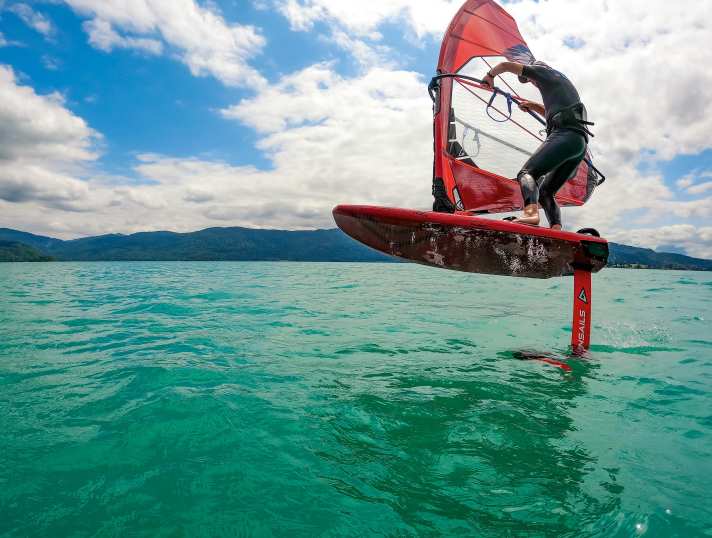
Haptics and handling
With its flat front screen and compact design, the GoPro looks handy and most inconspicuous. The lens is much less susceptible to damage than the protruding frog eyes of the 360. Operation is easy and the voice control can be used to switch between photo and video, for example, as well as to start and stop recordings.
Practical impressions from the short test
The GoPro delivers above all when you want to produce impressive slow motion. The 360-degree cameras can't keep up. Especially the 240fps at 2.7K are a milestone here. Another plus point (we have an affinity for print) is the continuous shooting speed. A surfer jumps past you in the water and - bang - you might have 2 to 3 really good single photos in the box on the first attempt. A continuous shooting interval of just 0.5 seconds makes it possible. We also use the GoPro version (still the "old" Hero 9 - still good) for such fast, safe water shots in the surf test (see photo above). However, the GoPro now seems too limited for video recordings, at least on the windsurfing rig. Perhaps this perspective from the surfer's point of view (on the helmet) is fun at regattas, otherwise changing the mounting points to get different perspectives is at least helpful for a varied video.
Important technical data of the GoPro Hero 13 black
- Price: 449 euros (as of 23 October 2025)
- Weight (surf measurement): 159 grams
- Dimensions (manufacturer's specification): 71.8 x 50.8 x 33.6 mm (W x H x D)
- Sensor size: 1/1.9 inch
- Maximum photo resolution: 5568 x 4872
- Shortest continuous photo interval: 0.5 seconds
- Interesting video resolutions: 5.3K/60fps (16:9), 4K/120 (16:9), 2.7K/240 (16:9)

